
Basque Burnt Cheesecake
Creamy on the inside and caramelized on the outside, this Basque Burnt Cheesecake is easier than it looks to make at home. Baked at a high temperature, the cheesecake‘s iconic rich dark top is a showstopper! Follow my tips and tricks for a foolproof recipe.
Ingredients
- 1 lb cream cheese (226 g x 2 blocks for 1 6-inch cake; I used Philadelphia brand; at room temperature)
- ½ cup sugar
- 3 large eggs (50 g each w/o shell) (at room temperature)
- 1 Tbsp lemon juice
- 2 Tbsp cake flour (or use all-purpose flour; use rice flour for gluten-free; measure using the “fluff and sprinkle“ method and level it off)
- 2 tsp cornstarch (or substitute with potato starch or cake flour)
- ⅛ tsp Diamond Crystal kosher salt
- 1 cup heavy (whipping) cream (at room temperature)
Instructions
Before You Start...
- Please note that this cake requires 2–3 hours of cooling time. You can serve it either at room temperature or chilled in the refrigerator for an additional 4 hours.
- Gather all the ingredients.
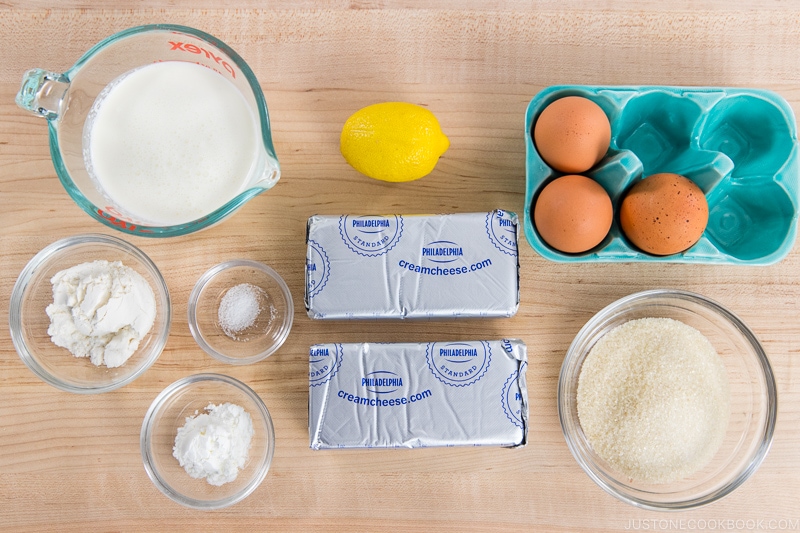
To Preheat the Oven
- Preheat a convection oven (with fan) to 450ºF (230ºC). If you don’t have an oven with a fan, preheat a conventional oven to 475ºF (245ºC). If your oven doesn’t heat up very well, you can preheat it to the hottest oven temperature (mine is 550ºF (290ºC)) for 30–60 minutes, then turn it down to the target temperature. As for the oven rack, I used the middle position in my convection oven (the fan circulates the air, so the middle rack is ideal). If you use a conventional oven, move the rack slightly higher as heat rises and the temperature toward the top of the oven is higher. However, keep in mind that a 3-inch deep cake pan needs extra space for rising.
To Prepare the Cake Pan
- Prepare two rectangular sheets of parchment paper long enough to hang over the sides of one 6-inch (15-cm) round cake pan by 2 inches (5 cm). Place them crisscross to maximize the coverage on all sides. (You can use just one sheet per cake pan if your parchment paper is extra wide.) Fold them twice into quarters, like a paper napkin.
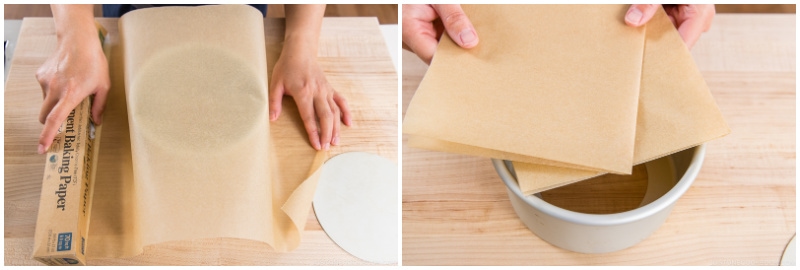
- Open the folded sheets and place them crisscross as before. Find the center point of the crisscrossed sheets. Where the creases intersect will also indicate the center of the cake pan. Center the parchment sheets over the cake pan ring, then center the removable bottom on top of the sheets.
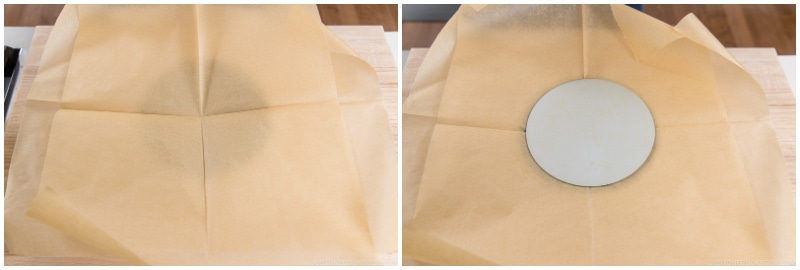
- Press down the removable bottom and the parchment sheets into the cake pan, creasing the paper against the bottom and inside of the pan to fit snugly. Press and crease the paper edges down around the outside of the cake pan, too.
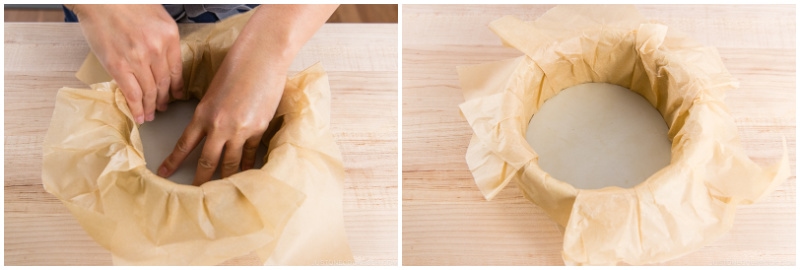
- Gently take out both the removable bottom and the parchment sheets, which are now molded into the shape of the pan. Place the removable bottom back into the cake pan (as it should be). Then, fit the molded parchment paper back into the cake pan on top of the removable bottom. Press the paper down to fit snugly. (If you‘re doubling the recipe, repeat this process with a second cake pan.)
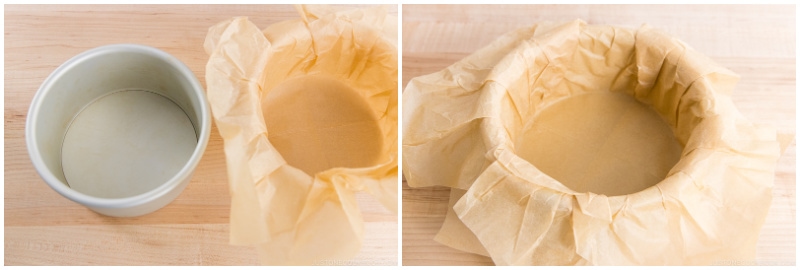
To Make the Batter
- Place 1 lb cream cheese in a large bowl. Make sure the cream cheese is at room temperature. If not, microwave the cold cream cheese at half power (50%) for 45 seconds, or microwave it in 15-second increments until it‘s at room temperature.
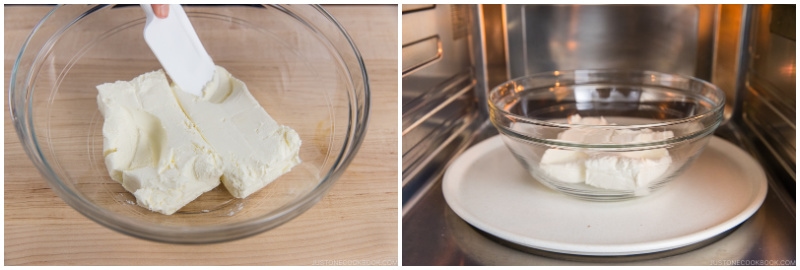
★ Hand Mixing Method
- Press down on the cream cheese with a spatula to soften it. Then, add ½ cup sugar. (For the blender method, scroll down to the next section.)
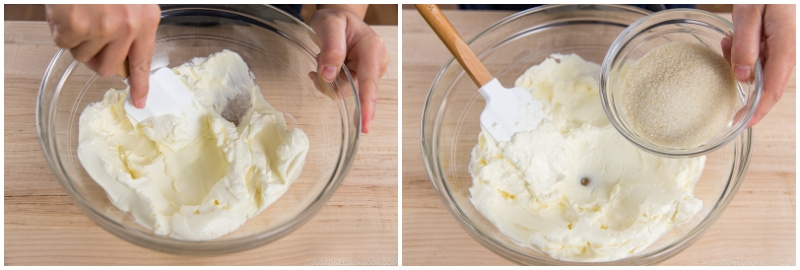
- Combine the cream cheese with the sugar by rubbing the mixture against the sides of the bowl with the spatula. The cream cheese will become fluffy and smooth as the sugar granules dissolve.
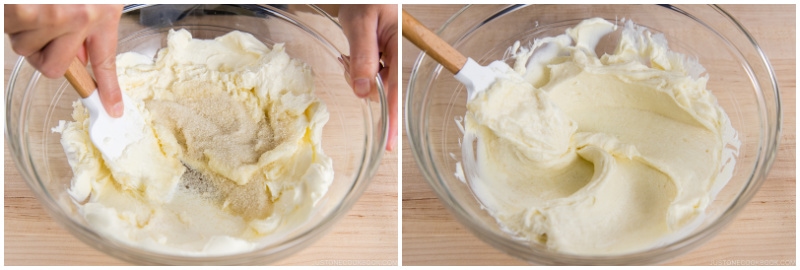
- Scrape both the bowl and spatula often to ensure that the ingredients are well incorporated and there are no lumps.
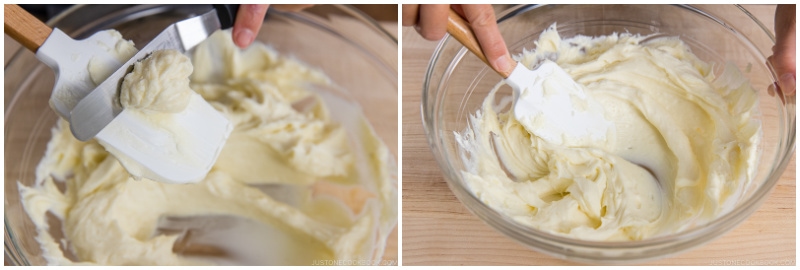
- Crack 3 large eggs (50 g each w/o shell) in another bowl and whisk well.
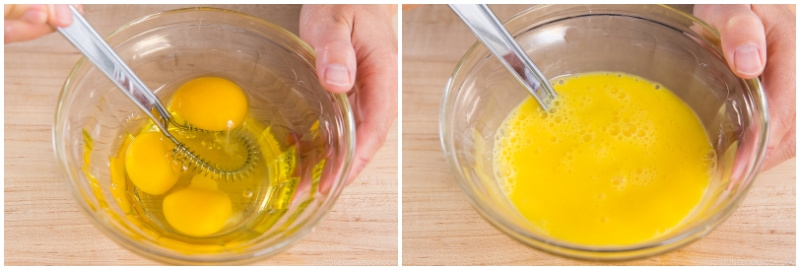
- Slowly and gradually add the beaten eggs to the cream cheese mixture, one-third at a time. Make sure the batter is smooth and with no lumps before adding more egg.
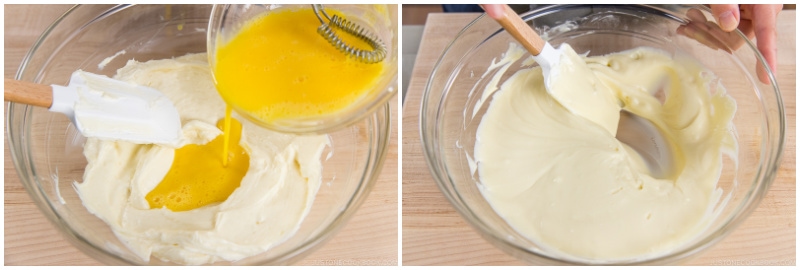
- After each addition, blend the eggs with the cream cheese THOROUGHLY and COMPLETELY.
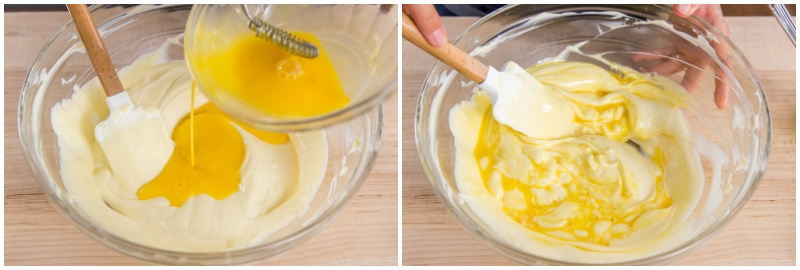
- Add the rest of the egg and blend well.
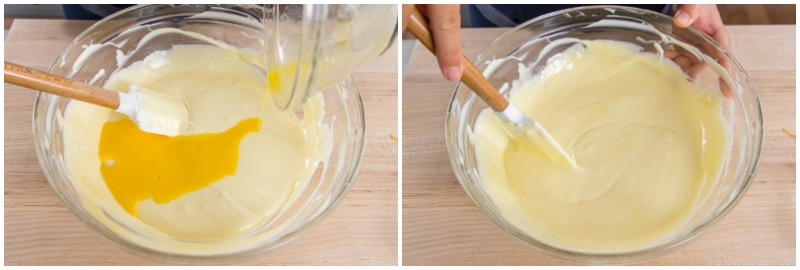
- Scrape the batter from the sides of the bowl and spatula, making sure there are no lumps in the batter. Then, add 1 Tbsp lemon juice and mix thoroughly.
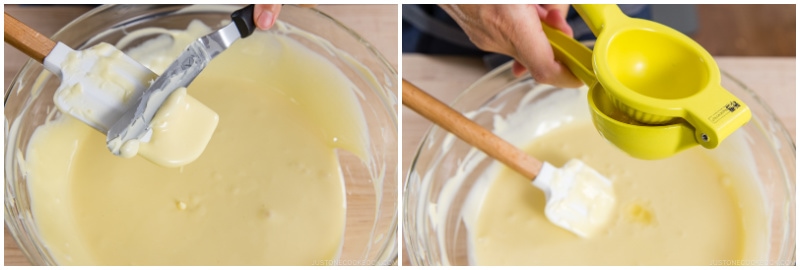
- Next, add 2 Tbsp cake flour and 2 tsp cornstarch to a sieve. Holding the sieve in one hand, sift a little bit of the flour and cornstarch into the cream cheese mixture while you stir with a spatula. Incorporate the ingredients well before adding more. Keep sifting and blending until you‘ve added all the flour mixture. Take your time doing this. You don’t want any lumps.
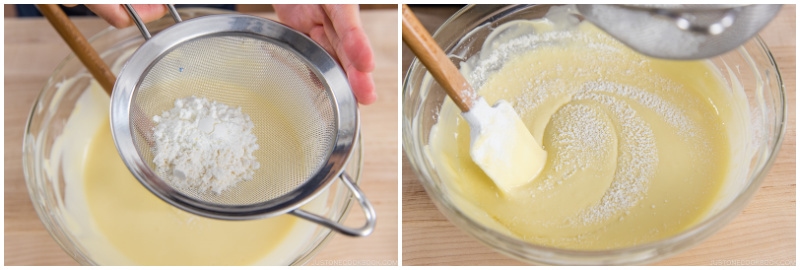
- Add ⅛ tsp Diamond Crystal kosher salt and blend together. Make sure at this stage (before adding the heavy cream--more liquid) that there are no lumps.
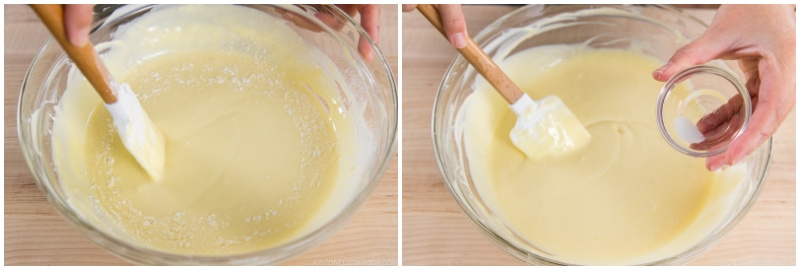
- Gradually add 1 cup heavy (whipping) cream while you stir. Mix until it’s all combined.
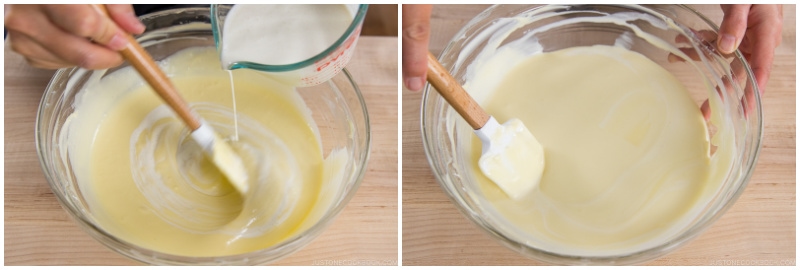
★ Blender Method
- Put all the ingredients for the cake batter in a blender (I use my Vitamix): 1 lb cream cheese, ½ cup sugar, 3 large eggs (50 g each w/o shell), 1 Tbsp lemon juice, 2 Tbsp cake flour, 2 tsp cornstarch, ⅛ tsp Diamond Crystal kosher salt, and 1 cup heavy (whipping) cream. Blend until very smooth, about 2 minutes. Then, let this mixture rest for 15 minutes to let the air bubbles in the batter settle, or else the cake may crack.
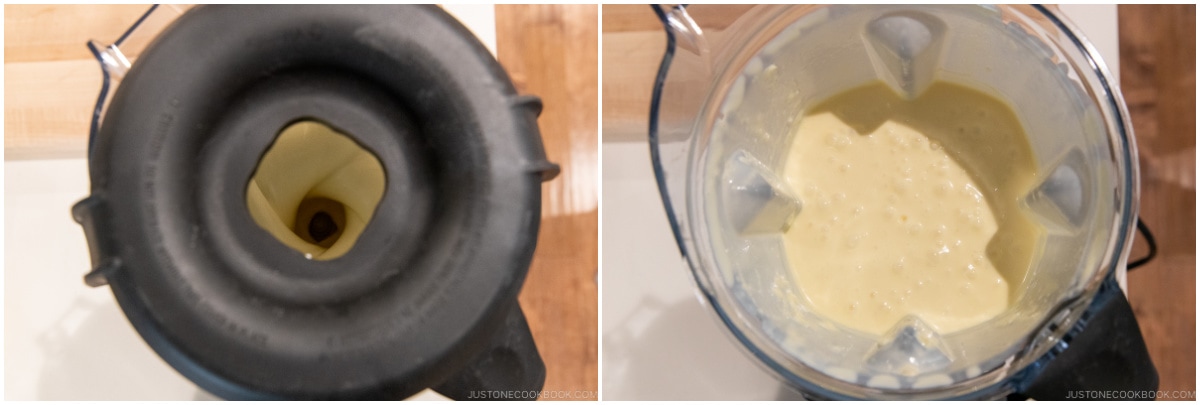
To Pour the Batter into the Pan
- Pour the cake batter into the prepared pan in one go (avoid stop-and-go) so you don‘t create any air pockets. Tap the cake pan on the countertop a few times to eliminate air pockets.
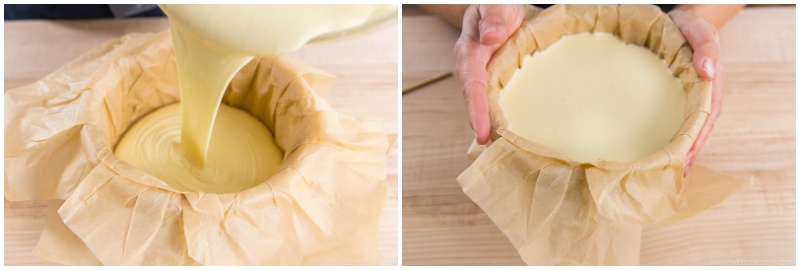
- With a bamboo skewer or toothpick, pop the air bubbles if there are any. Then, run the skewer through the batter to remove any bubbles. Since the cheesecake may overflow during baking, place the cake pan on a baking sheet, just in case. Mine never did, but I still use a baking sheet as it helps to transfer the cake pan to and from the oven.
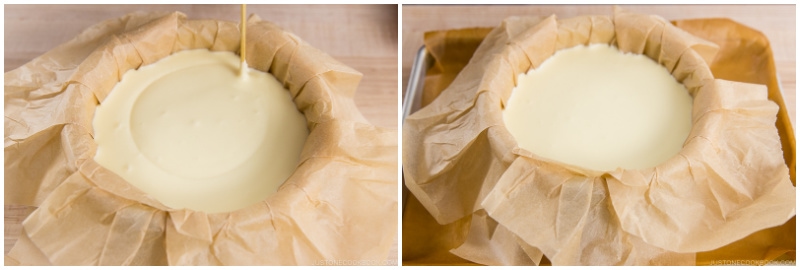
To Bake
- Transfer the baking sheet with the cake pan to the oven and bake at 450ºF (230ºC) for a convection oven or 475ºF (245ºC) for a conventional oven. Bake until the top is dark amber/brown and the center is still very jiggly, about 30–35 minutes (please keep an eye on your cheesecake because every oven is different). The top of my cheesecake starts becoming dark at the 30-minute mark, then gets dark brown within 5 minutes. If you love a “gooey“ or “oozy“ texture, then you may bake for less time than I suggested, but you must chill your cake well to firm it up before serving. NEVER extend the bake time and thus overcook the cake, even if the top hasn‘t turned dark. The filling will curdle and you can‘t fix it. If the top doesn‘t darken within 30–35 minutes, you will probably need to adjust the oven temperature (or oven rack or preheating time) the next time you make it.
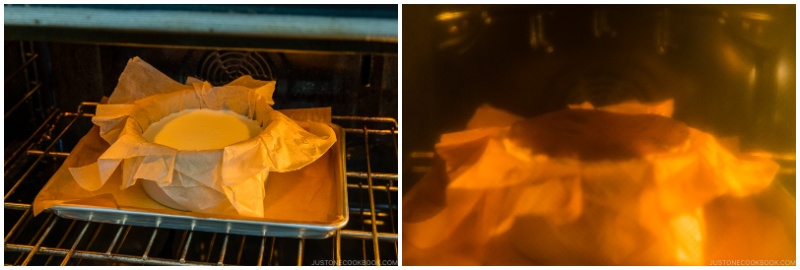
To Cool
- Take out the cake when the surface is a dark, burnt color. The cake should wobble when you gently shake the pan. Let the cheesecake cool in the pan on a wire rack until it reaches room temperature, about 2–3 hours. Don’t put it on the countertop directly, and make sure the air can circulate under the cake pan. You can place it on top of your gas range burner grate, if it‘s not in use.
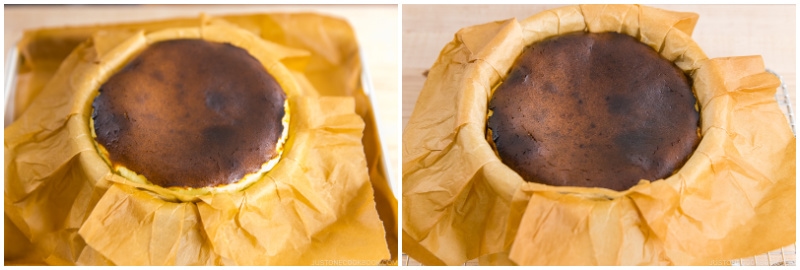
To Chill
- You can serve the cake either chilled or at room temperature (which we like, too). For a chilled or firmer cheesecake, cover the cake in the pan with a tea towel (don‘t use plastic, as condensation may drip onto the cake), and place in the refrigerator for 4 hours.
To Serve
- Remove the cheesecake from the cake pan and carefully peel back the parchment paper. If you have chilled the cake, let it stand at room temperature for at least 30 minutes or up to 2 hours before serving.
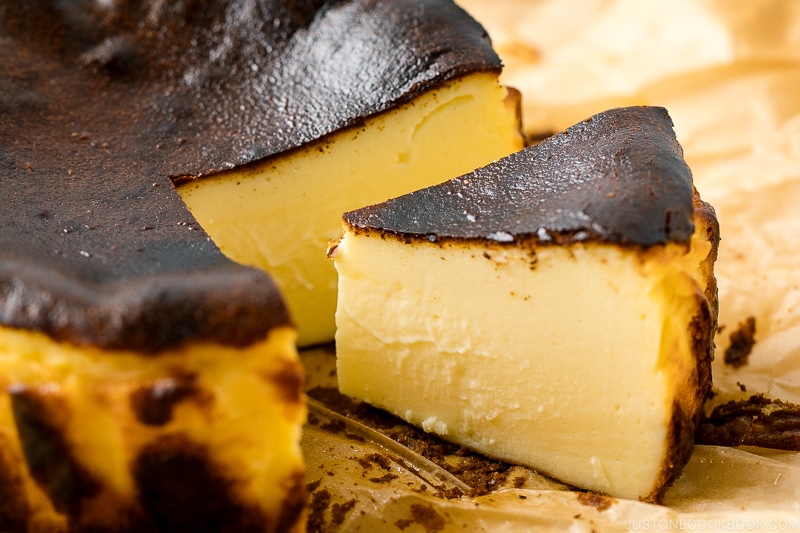
To Store
- You can store the cheesecake in the refrigerator for up to 3 days.
Nutrition
Serving: 6inch cake, Calories: 3043kcal, Carbohydrates: 141g, Protein: 52g, Fat: 258g, Saturated Fat: 147g, Trans Fat: 1g, Cholesterol: 1383mg, Sodium: 1901mg, Potassium: 1043mg, Fiber: 1g, Sugar: 116g, Vitamin A: 10402IU, Vitamin C: 7mg, Calcium: 687mg, Iron: 5mg